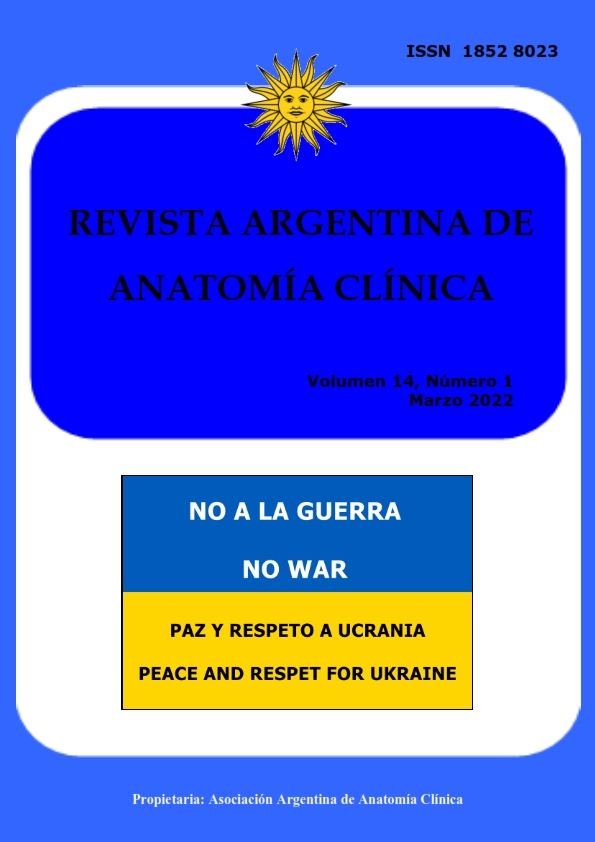Frequency of the transverse ligament of the knee. Anatomical study with correlation by magnetic resonance imaging
DOI:
https://doi.org/10.31051/1852.8023.v14.n1.36591Keywords:
Anatomy, Knee joint , Menisci, Ligaments, ImagingAbstract
Introduction: The menisci are two fibrocartilages intended to improve coaptation between the articular surfaces of the femorotibial knee joint. In an inconsistent manner, these are united, at the level of their anterior horns, by the transverse ligament. In magnetic resonance imaging, the insertion of the transverse ligament can give rise to a false image (pitfall) of a tear of the anterior horn of the menisci, by generating a high signal line between the ligament and the anterior horn. The objective of the present work is to determine the frequency of the transverse ligament in cadaveric material and in magnetic resonance imaging. Materials and method: 35 knees were dissected fromadult corpses fixated in formaldehyde, of both sexes, 18 right and 17 left, without ostensible osteoarticular pathology. 195 magnetic resonances of the knees of adult patients, performed since January 2019 until October 2020 at the Hospital de Clínicas were reviewed. In both cases the frequency of the transverse ligament was recorded. Results: Cadaveric study: the transverse ligament was found in 25 cases (71.4%). Imaging study: 2 magnetic resonances had exclusion criteria. The transverse ligament was found in 105 cases (54.4%). Conclusion: The transverse ligament was found in more than half of the individuals studied, regardless of the method. This is relevant considering the clinical and imaging importance of the ligament.
References
Aydingöz Ü, Kaya A, Atay ÖA, Öztürk HM, Doral MN. 2002. MR imaging of the anterior intermeniscal ligament: Classification according to insertion sites. Eur Radiol 12: 824–829.
Berlet GC, Fowler PJ. 1998. The anterior horn of the medial meniscus. An anatomic study of its insertion. Am J Sports Med 26: 540–543.
Balta JY, Twomey M, Moloney F, Duggan O, Murphy KP, O'Connor OJ, Cronin M, Cryan JF, Maher MM, O'Mahony SM. 2019. A comparison of embalming fluids on the structures and properties of tissue in human cadavers. Anat Histol Embryol. 48:64-73.
Erbagci H, Yildirim H, Kizilkan N, Gümüsburun E. 2002. An MRI study of the meniscofemoral and transverse ligaments of the knee. Surg Radiol Anat 24: 120–124.
Franke J, Mueckner K, Alt V, Schnettler R, Franke AP, Griewing S, Hohendorff B. 2020. Anterior intermeniscal ligament: frequency in MRI studies and spatial relationship to the entry point for intramedullary tibial nailing related to the risk of iatrogenic violation. Eur J Trauma Emerg Surg. 46: 1085-1092.
Guess TM, Razu SS, Kuroki K, Cook JL. 2017. Function of the Anterior Intermeniscal Ligament. J Knee Surg 31: 68–74.
Kang CW, Wu LX, Pu XB, Tan G, Dong CC, Yan ZK, Liu L. 2021. Pseudotear Sign of the Anterior Horn of the Meniscus. Arthroscopy 37: 588-597.
Kohn D, Moreno B. 1995. Meniscus insertion anatomy as a basis for meniscus replacement: A morphological cadaveric study. Arthroscopy 11: 96–103.
Marcheix PS, Marcheix B, Siegler J, Bouillet P, Chaynes P, Valleix D, Mabit C. 2009. The anterior intermeniscal ligament of the knee: an anatomic and MR study. Surg Radiol Anat 31:331-334.
Morris H, Churchill J, Churchill A. 1879. The Anatomy of the Joints of Man. Philadelphia: Lindsay and Blakiston, pag: 342-377.
Nelson EW, LaPrade RF. 2000. The anterior intermeniscal ligament of the knee. An anatomic study. Am J Sports Med 28:74-76.
Rodrigues de Abreu MR, Chung CB, Trudell D, Resnick D. 2007. Anterior transverse ligament of the knee: MR imaging and anatomic study using clinical and cadaveric material with emphasis on its contribution to meniscal tears. Clin Imaging 31:194-201.
Rouviere H, Delmas A. 2005. Anatomía Humana descriptiva, topográfica y funcional. 11a edición, Barcelona: MASSON, S.A., pag 374.
Tan HK, Bakri MM, Peh WC. 2014. Variants and pitfalls in MR imaging of knee injuries. Semin Musculoskelet Radiol 18:45-53.
Testut J, Latarjet A. 1984. Tratado de Anatomía Humana. Tomo primero: osteología, artrología y miología. 9a edición, Barcelona: Salvat editores, pag 684.
Tubbs RS, Michelson J, Loukas M, Shoja MM, Ardalan MR, Salter EG, Oakes WJ. 2008. The transverse genicular ligament: anatomical study and review of the literature. Surg Radiol Anat 30:5-9.
Watanabe AT, Carter BC, Teitelbaum GP, Bradley WG Jr. 1989. Common pitfalls in magnetic resonance imaging of the knee. J Bone Joint Surg Am 71:857-862.
Downloads
Published
Issue
Section
License
Copyright (c) 2022 Camila Rodriguez, María F. Ignatov Galan, Germán Gutiérrez Suárez

This work is licensed under a Creative Commons Attribution-NonCommercial 4.0 International License.
Authors retain copyright and grant the journal right of first publication with the work simultaneously licensed under a Creative Commons Attribution License that allows others to share the work with an acknowledgement of the work's authorship and initial publication in this journal. Use restricted to non commercial purposes.
Once the manuscript has been accepted for publications, authors will sign a Copyright Transfer Agreement to let the “Asociación Argentina de Anatomía Clínica” (Argentine Association of Clinical Anatomy) to edit, publish and disseminate the contribution.



